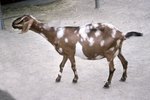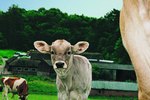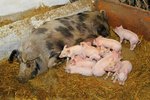Predicting when a cow will calve is as much an art as a science. While some signs of impending calving are obvious, others depend on close and knowledgeable observation. When a cow's due date nears, check her at least three times a day for such signs. For heifers -- young bovines giving birth for the first time -- it's advisable to check four or five times daily.
Bovine Gestation
On average, a cow's gestation period is 283 days, or a little over nine months. While it's easy to figure out the due date from when the cow was bred or inseminated, "average" is just that. Ten days early or late falls within the normal range.
If you know when your cow has previously delivered calves, it's quite possible that her gestational period will stay similar for each birth. A cow might carry a bull calf a few days longer than a heifer, based not on "old farmer's tales" but on hormonal influences. When choosing a bull as a sire, consider the gestational dates of their offspring. Longer gestational dates appear to run in certain lines, and you might want to avoid that.
Behavioral Changes
Perhaps the most obvious changes in a cow before calving are behavioral. The animal becomes restless, perhaps frequently getting up and lying down. She isolates herself from the rest of the cows. If you have a large herd, make sure to do a head count every night, so you know immediately if one or two cows aren't present. Before calving, cows lose interest in eating. If possible, create a special pasture strictly for cows close to their due dates.
Physical Changes
Within 24 hours of calving, the cow's pelvic ligaments relax and her vulva enlarges. The pelvic ligaments are located between her buttock points and tail head on either side of the tail. Once relaxed, those areas appear sunken. That's a more dependable sign of imminent delivery than teat strutting, or when the udder fills up and the teats push outward. In some cows, the udder fills days before the actual calving, while others might not fill until after the calf is born. Heifers often develop large udders weeks before their first calf arrives.
Cervical Dilation
Cervical dilation starts just prior to calving, with the cervix closed before that point. If you aren't familiar with checking your cow's cervix, have your vet show you. You should know how many fingers you can insert into the closed cervix of a particular cow, so that dilation becomes obvious. In cows who have had several calves, it may be possible to insert up to four fingers partway into the closed cervix. If you can stick your entire (gloved) hand into the cervix, expect calving within 24 hours, and often much sooner.
References
- University of Nebraska Lincoln Extension: Know the Signs of Impending Calving in Cows or Heifers
- Virginia Cooperative Extension: The Cow-Calf Manager
- Colorado State University College of Veterinary Medicine & Biomedical Sciences: Calving and Handling Calving Difficulties
- Progressive Cattleman: When Will She Calve?
- Mississippi State University Extension Service: Beef Cattle Calving Management
Photo Credits
-
Digital Vision./Digital Vision/Getty Images
Writer Bio
Jane Meggitt has been a writer for more than 20 years. In addition to reporting for a major newspaper chain, she has been published in "Horse News," "Suburban Classic," "Hoof Beats," "Equine Journal" and other publications. She has a Bachelor of Arts in English from New York University and an Associate of Arts from the American Academy of Dramatics Arts, New York City.




